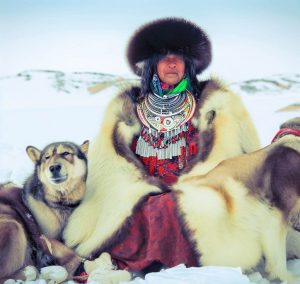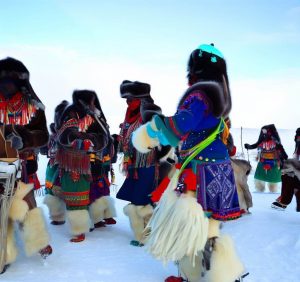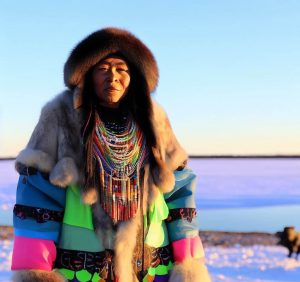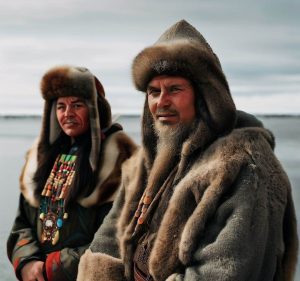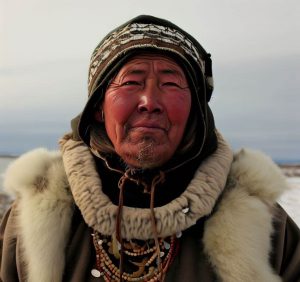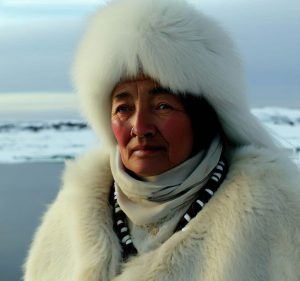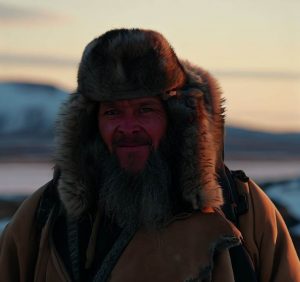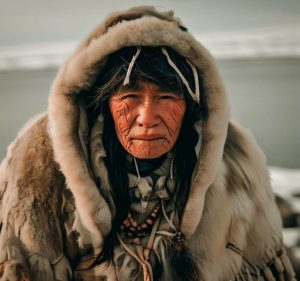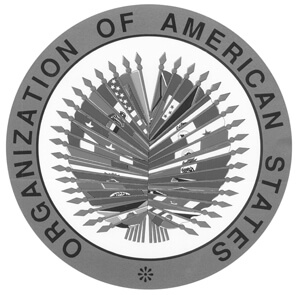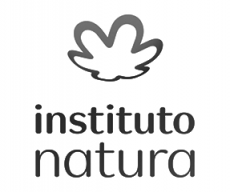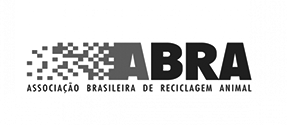English to Inuktitut Translation Services
Unveiling the Past: The Origins and History of the Inuktitut People
Introduction
The Inuktitut people, or Inuit, have a rich history that spans thousands of years. Their unique culture and way of life have been shaped by the harsh Arctic environment they call home.
With strong ties to their ancestral lands and an incredible ability to adapt, the Inuit have managed to thrive despite the many challenges they have faced.
This article explores the origins and history of the Inuktitut people, delving into their migration, adaptation, and interactions with other indigenous peoples.
Thule Culture and Migration
The Inuit's ancestors are believed to have originated from Siberia, crossing the Bering Strait into Alaska around 1000-2000 BCE.
They eventually migrated across the Canadian Arctic, forming the Thule culture around 1000 CE. This culture is known for its advanced hunting and marine technology, which allowed them to adapt to the harsh Arctic environment.
The Thule people are considered the direct ancestors of the Inuit and their way of life is still reflected in modern Inuit culture.
Get an estimate for our Inuktitut language translation services
Inuit Adaptation to the Arctic Environment
The Inuit's ability to adapt to the harsh Arctic environment is one of the most remarkable aspects of their culture. Over thousands of years, they have developed a range of strategies to survive in the unforgiving climate.
Some of these include:
Developing innovative hunting techniques and tools, such as harpoons, to catch seals, whales, and other marine mammals.
Constructing unique, well-insulated shelters like the igloo, which can be built quickly from snow and ice, providing temporary shelter from the extreme cold.
Mastering dog sled transportation, which enabled them to travel long distances across the ice in search of food and resources.
Interaction with Other Indigenous Peoples
As the Inuit migrated across the Arctic, they interacted with other indigenous groups, such as the Dorset and Tuniit people. While there is evidence of conflict between the Inuit and these groups, there were also instances of trade and cultural exchange.
Eventually, the Thule culture outlasted and absorbed the Dorset and Tuniit cultures, with the Inuit becoming the predominant indigenous group in the Arctic.
The Inuit also encountered the Norse settlers of Greenland, who arrived around 980 CE. Although there were some conflicts, trade relations were established between the two groups, with the Norse providing valuable resources like iron and wood, while the Inuit traded furs and other Arctic goods.
The Inuktitut people's history is a fascinating tale of resilience, adaptation, and cultural evolution. As the direct descendants of the Thule culture, the Inuit have managed to survive and thrive in one of the most inhospitable environments on Earth.
Understanding the origins and history of the Inuktitut people is essential to appreciating the rich and diverse tapestry of human civilization.
Preserving Inuit Cultural Heritage
The Inuit have faced numerous challenges throughout their history, from adapting to a harsh environment to interacting with other indigenous peoples and colonizers.
In recent times, the Inuit have had to contend with rapid modernization and globalization, which have threatened to erode their traditional way of life.
However, the Inuit community has taken active steps to preserve and protect their cultural heritage in various ways.
Cultural Institutions and Museums
One key approach to preserving Inuit culture is the establishment of cultural institutions and museums that showcase and celebrate their history, language, and traditions.
Institutions like the Inuit Cultural Institute in Nunavut, the Avataq Cultural Institute in Quebec, and the Inuit Art Foundation in Ontario work tirelessly to document, research, and promote Inuit culture.
These organizations also provide resources and support for the Inuit community, helping to ensure that their cultural heritage is passed down to future generations.
Reviving Traditional Skills and Knowledge
Efforts to preserve Inuit culture also focus on reviving traditional skills and knowledge. Initiatives such as the Qaggiavuut Society in Nunavut support the revitalization of Inuit performing arts like drum dancing, throat singing, and storytelling.
Traditional craftsmanship is also being promoted, with a focus on skills like stone, bone, and ivory carving, as well as the creation of traditional clothing from sealskin and fur.
Elders play a crucial role in passing down traditional knowledge and skills to younger generations. They often act as mentors, teaching the youth about the history, language, and way of life of their ancestors.
This intergenerational exchange is vital for ensuring the survival and continuity of Inuit culture.
Get an estimate for our Inuktitut language translation services
Inuit Language Preservation
The Inuktitut language is a critical aspect of Inuit culture and identity. To preserve the language, various measures have been taken, such as the establishment of bilingual education programs and the use of Inuktitut in government and media.
In Nunavut, for example, Inuktitut is an official language, and efforts are being made to promote its use in public services, education, and daily life.
Inuit Land Claims and Self-Determination
Over the past few decades, the Inuit have made significant strides in securing their rights and self-determination. Land claim agreements, such as the Nunavut Land Claims Agreement and the creation of the Nunavut Territory in 1999, have given the Inuit greater control over their lands and resources.
These developments have provided the Inuit with a platform to address issues related to their culture, language, and way of life.
Despite the numerous challenges they have faced, the Inuit have remained resilient, taking proactive measures to preserve their culture and heritage.
From the establishment of cultural institutions to the revitalization of traditional knowledge and language, the Inuit community has demonstrated its commitment to ensuring the continuity of their unique way of life.
As we continue to learn from the Inuit's rich history and cultural heritage, it is important to support their efforts in preserving their identity for generations to come.
Inuit Representation in Media and the Arts
As the Inuit strive to preserve their cultural heritage, representation in media and the arts has become increasingly important.
This visibility not only allows the Inuit to showcase their unique culture and traditions but also helps to challenge stereotypes and misconceptions about their way of life.
Inuit Filmmaking
Inuit filmmakers have gained international recognition for their work, with many films focusing on the realities of life in the Arctic and providing a rare glimpse into the everyday experiences of the Inuit.
Films such as "Atanarjuat: The Fast Runner" (2001), directed by Zacharias Kunuk, and "The Grizzlies" (2018), directed by Miranda de Pencier, have achieved critical acclaim and raised awareness about Inuit culture and the challenges they face.
Television and Radio
Television and radio programs in Inuktitut have also played a vital role in preserving the language and connecting Inuit communities.
The Inuit Broadcasting Corporation (IBC) and Nunavut Independent Television Network (NITV) are examples of media organizations that produce content in Inuktitut, ranging from news programs to cultural shows and children's programming.
Get an estimate for our Inuktitut language translation services
Inuit Music and Performing Arts
Inuit musicians and performers have also made an impact on the global stage, showcasing their unique art forms and preserving their cultural heritage.
Tanya Tagaq, a renowned throat singer, and The Jerry Cans, a popular Inuit indie rock band, have gained international recognition for their music.
They not only perform traditional Inuit music but also incorporate modern elements, creating a fusion that resonates with both Inuit and non-Inuit audiences.
Contemporary Inuit Visual Arts
Inuit visual artists, such as Kenojuak Ashevak, Annie Pootoogook, and Tim Pitsiulak, have achieved international recognition for their work, which often incorporates traditional Inuit themes and imagery.
Their art has been exhibited in galleries and museums worldwide, helping to raise awareness of Inuit culture and traditions.
Inuit visual arts have also evolved to incorporate modern techniques and materials, reflecting the ongoing adaptation and resilience of Inuit culture.
Challenges and Opportunities
While the Inuit have made significant strides in preserving their culture and raising awareness through media and the arts, challenges remain.
Many Inuit artists and performers face limited access to resources, funding, and professional opportunities, particularly those living in remote communities.
To overcome these challenges, continued support for Inuit artists, performers, and media organizations is crucial.
The Inuit have demonstrated their commitment to preserving their cultural heritage and identity through increased representation in media and the arts.
By showcasing their unique traditions, language, and way of life, they are not only challenging stereotypes and misconceptions but also ensuring that their culture remains vibrant and relevant for future generations.
As we celebrate the achievements of Inuit artists, performers, and media organizations, it is crucial that we continue to support their efforts and help create a world where Inuit culture can thrive.
Get an estimate for our Inuktitut language translation services
The Fabric of Inuit Life: Social Structure and Traditions
The Inuit people have developed a unique social structure and set of traditions that have helped them thrive in one of the most challenging environments on Earth.
This topic delves into the Inuit's kinship system, family roles, and traditional gender roles, as well as their rich heritage of storytelling, music, and dance.
Inuit Kinship System and Family Roles
The Inuit kinship system is central to their social structure, with strong emphasis on the importance of family and community ties.
In traditional Inuit society, extended families often lived and worked together in small, semi-nomadic hunting groups. These groups, called ilagiit or ilagiit nunagivaktangit, were united by a shared hunting territory and bonds of interdependence.
Family roles within the Inuit community were clearly defined, with each member contributing to the group's survival. Elders held a vital position as the guardians of knowledge and wisdom, responsible for passing down their expertise and cultural traditions to younger generations.
Parents and other adult family members played essential roles in raising children, teaching them essential life skills and the values of cooperation and respect.
Traditional Gender Roles and Expectations
In traditional Inuit society, gender roles were well-defined, with men and women having distinct responsibilities that contributed to the overall well-being of the community.
Men were primarily responsible for hunting, constructing shelters, and providing protection, while women were responsible for child-rearing, food preparation, and making clothing from animal hides.
However, these roles were not strictly enforced, and both genders could engage in activities traditionally assigned to the other if needed.
The Inuit have always valued flexibility and adaptability, which has allowed for a certain level of fluidity in gender roles.
This is exemplified by the concept of sipiniq, where an individual born as one gender was believed to have the spirit of the opposite gender and could assume the roles and responsibilities associated with that gender.
Storytelling, Music, and Dance
The Inuit have a rich heritage of storytelling, music, and dance, which served as a means of entertainment, education, and cultural preservation.
Oral storytelling played a crucial role in passing down the history, legends, and moral teachings of the Inuit people. Storytellers held an esteemed position within the community, and their tales were shared during long winter nights or community gatherings.
Music and dance have also been integral to Inuit culture, with unique forms such as throat singing, drum dancing, and the use of traditional instruments such as the qilaut (frame drum).
Throat singing, or katajjaq, is a unique vocal technique performed primarily by women, often as a friendly competition. Drum dancing is a traditional Inuit dance that involves rhythmic movements and the use of a qilaut to accompany storytelling and celebrations.
The social structure and traditions of the Inuit people have been shaped by their unique environment and the need for cooperation, adaptability, and resilience.
By understanding the importance of kinship, family roles, and traditional gender roles, as well as the rich heritage of storytelling, music, and dance, we can gain a deeper appreciation for the Inuit's way of life and the valuable lessons it can offer to the wider world.
As the Inuit continue to navigate the challenges of modernization and globalization, it is crucial that we support their efforts to preserve and celebrate their unique cultural identity.
Get an estimate for our Inuktitut language translation services
Embracing the Spirit of the Arctic: Inuit Spiritual Beliefs, Cosmology, and Connection to Nature
The Inuit people possess a rich tapestry of spiritual beliefs and practices that are deeply intertwined with their natural surroundings.
This topic explores the Inuit's spiritual beliefs, their practice of shamanism and traditional healing, their profound relationship with the environment and animals, and their intriguing cosmology and mythology.
Inuit Spiritual Beliefs
Inuit spirituality is rooted in animism, the belief that all living and non-living things possess a spirit or soul. This belief system instills a deep respect for the natural world, as the Inuit recognize the interconnectedness of all things and the delicate balance that must be maintained for survival in their harsh environment.
The spiritual beliefs of the Inuit are diverse and can vary among different communities, but their reverence for the land, animals, and the forces of nature remains a common thread.
Shamanism and Traditional Healing Practices
Shamans, or angakkuq, play a vital role in traditional Inuit society, acting as intermediaries between the human world and the spirit world.
Through their spiritual practices, shamans have the ability to communicate with spirits, heal the sick, and influence events in the natural world.
They employ various techniques, such as drumming, dancing, and chanting, to enter a trance-like state and perform their spiritual work.
Traditional healing practices in Inuit society often involve the use of medicinal plants, rituals, and spiritual guidance from the shaman.
These practices are deeply rooted in the understanding that illness and suffering can be the result of spiritual imbalances or the influence of malevolent spirits.
By addressing the spiritual aspects of illness, traditional healing practices aim to restore balance and harmony within the individual and the community.
Relationship with the Environment and Animals
The Inuit have a profound relationship with their environment and the animals they share it with. This bond is reflected in their spiritual beliefs, hunting practices, and the stories they tell.
The Inuit view animals as their equals, possessing their own unique intelligence and spirituality. They believe that when an animal is killed, its spirit must be treated with respect and gratitude to ensure its reincarnation and the continued availability of game for future generations.
This respect for animals is evident in Inuit hunting practices, which emphasize sustainability, conservation, and minimal waste. Hunters are expected to use every part of the animal, honoring its spirit and acknowledging its sacrifice.
Traditional rituals and ceremonies, such as the Nalukataq (whale festival), are performed to show gratitude and maintain a harmonious relationship with the animal world.
Inuit Cosmology and Mythology
Inuit cosmology and mythology offer a captivating glimpse into their beliefs about the origins of the world, the forces of nature, and the complex relationships between humans, animals, and the spirit world.
Inuit myths often feature a diverse cast of characters, including gods, spirits, animals, and humans, and serve to explain natural phenomena and convey important moral lessons.
Sedna, the sea goddess, is a central figure in Inuit mythology. She is believed to control the abundance of marine life and is propitiated by shamans to ensure successful hunts.
Another prominent figure is Nanook, the polar bear spirit, who is revered for his strength, wisdom, and hunting prowess.
Inuit myths often emphasize the importance of respecting the natural world, maintaining harmonious relationships with animals, and adhering to the customs and taboos of their society.
Get an estimate for our Inuktitut language translation services
The Richness of Inuktitut: Language Characteristics, Revitalization, and the Role of English to Inuktitut Translation
The Inuktitut language is a remarkable and complex language with unique characteristics. In this topic, we will cover the Inuktitut language's polysynthetic nature, writing systems, linguistic variations, and revitalization efforts.
As part of these revitalization efforts, English to Inuktitut translation plays a crucial role in preserving and promoting the language.
Inuktitut Language Characteristics
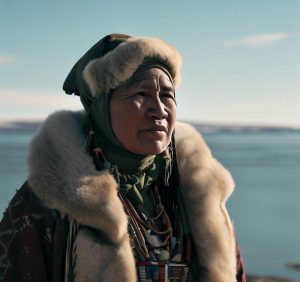
Polysynthetic Nature
Inuktitut is a polysynthetic language, meaning that words are formed by combining several smaller units, or morphemes, to convey complex ideas.
This feature allows for the creation of long and expressive words that encompass entire sentences in other languages. English to Inuktitut translation requires a deep understanding of this polysynthetic structure to accurately convey meaning between the two languages.
Unique Writing Systems: Syllabics and Latin Alphabet
Inuktitut boasts two unique writing systems: syllabics and the Latin alphabet. Syllabics, derived from the Cree syllabary, is the most commonly used writing system in the Canadian Arctic.
The Latin alphabet, used primarily in Greenland, is known as the roman orthography. English to Inuktitut translation often necessitates the conversion between these writing systems to ensure accessibility and understanding among different Inuit communities.
Linguistic Variations Across Inuit Regions
The Inuktitut language exhibits significant linguistic variations across different Inuit regions, with multiple dialects and subdialects.
These variations can pose challenges in English to Inuktitut translation, as translators must be familiar with the specific dialect of the target audience to ensure accurate and culturally appropriate translations.
Inuktitut Language Revitalization

Government Initiatives and Support
Recognizing the importance of preserving the Inuktitut language, various government initiatives and support have been established in the Canadian Arctic.
Nunavut, for example, declared Inuktitut as one of its official languages, paving the way for increased funding and support for language preservation efforts.
English to Inuktitut translation is a vital component of these efforts, as it enables the creation of bilingual materials and resources.
Inuit Language Schools and Bilingual Education
Inuit language schools and bilingual education programs have emerged as essential tools for preserving the Inuktitut language.
These programs aim to teach both Inuktitut and English, fostering bilingualism and ensuring that Inuit children maintain a strong connection to their cultural heritage.
English to Inuktitut translation is indispensable in creating educational materials for these programs, promoting language learning and revitalization.
Get an estimate for our Inuktitut language translation services
The Role of Media and Technology in Language Preservation
In the modern era, media and technology have become powerful allies in the preservation of the Inuktitut language. Inuit media organizations, such as the Inuit Broadcasting Corporation (IBC) and Nunavut Independent Television Network (NITV), produce content in Inuktitut, ranging from news programs to cultural shows and children's programming.
English to Inuktitut translation is essential in producing these media resources, as it allows for the adaptation of content for Inuit audiences.
In addition, technology has facilitated the development of language tools and resources, such as dictionaries, mobile apps, and online learning platforms.
English to Inuktitut translation is a key aspect of these tools, enabling Inuit speakers to access information, learn, and communicate more effectively in their native language.
The Inuktitut language, with its unique characteristics and regional variations, is a testament to the rich cultural heritage of the Inuit people.
As efforts to revitalize and preserve the Inuktitut language continue, English to Inuktitut translation plays a vital role in bridging the gap between languages and cultures.
By supporting bilingual education, media production, and the development of language tools, English to Inuktitut translation contributes to the maintenance and growth of the Inuktitut language in the modern world.
Moreover, the ongoing support from government initiatives and the integration of technology in language preservation efforts have provided a strong foundation for the Inuktitut language to thrive.
English to Inuktitut translation has become an indispensable tool for fostering connections between Inuit communities, allowing for the sharing of knowledge, stories, and cultural values.
In conclusion, the Inuktitut language, with its rich history and unique characteristics, remains an essential aspect of the Inuit people's identity.
By embracing English to Inuktitut translation and supporting language revitalization efforts, we can ensure that future generations continue to celebrate and cherish this beautiful and complex language.
The preservation of the Inuktitut language not only enriches the lives of the Inuit people but also contributes to the cultural diversity and richness of our global community.
It is estimated that there are 35,000 speakers of Inuktitut in Canada.
Inuktitut is the native language of the Inuit peoples, and it is traditionally spoken across the North American Arctic.
TripleTrad Canada can help you with English to Inuktitut translation.
TripleTrad Canada only hires native speakers for each translation project, including for the translation of North American indigenous languages.
When you need an English to Inuktitut translation, qualified, and experienced translators who are native speakers of the target language are imperative.
Our native translators are experienced in industries and areas specific to the needs of individuals, businesses, and organizations/institutions.
If you need an English to Inuktitut translation, you cannot risk mistakes or misunderstandings.
Style, tone, accuracy and words with multiple meanings can be easily confused. Inuktitut has over eight different dialects.
Inuktitut dialects change gradually over each geographical area. Speakers of geographical areas far apart from each other may not be able to understand each other.
TripleTrad Canada guarantees that each and every translation project follows a unique, multi-step proofreading and verification process.
We know how hard it can be to find an exceptional Inuktitut translator when you need one. That’s where we come in: we give your international business endeavours direction and power, enabling you to be just as effectively overseas as you are locally.
We work as if we were a translation department within your own company, except you don’t need to worry about the hassles of contracting workers or finding professional translators for your business documents.
You only pay per project, with no recurring or monthly fees.
At TripleTrad Canada, we are passionate about helping your business and projects gain publicity and new audiences both locally and internationally.
If you have any questions about our English to Inuktitut translation services, reach out to us at +1 (647) 499-1178 (Toronto area and Canada). You can also contact us on Whatsapp (click here). 🙂
Get an Estimate Now
You might also be interested in:

Certified Translation Services

Accurate Translation Services in Canada

Fast Response Time: We Live in the Future
Projects in 2023
5720
Language combinations
312
Team members across the planet
1200
Happy clients worldwide
3245
WHO WE SERVE
TripleTrad is a thriving business with over 10 years of delivering comprehensive translation services across 300 languages to both fledgling and long-established organizations. Our services have assisted companies in fields such as:
- Advertising, Architecture
- Design, Education, Engineering
- Financial, Legal
- Manufacturing, Medical
- Multimedia, Technology
What clients say about us
"Reliable service"
96%
"Amazing turnaround time"
93%
"Accurate"
94%

Professional translation services

Reliable support




